THEM was always working on doing more and better entertaining performances to please the audience, plant memories and build more call-backs for more engagements. In addition to our sounds, we wanted our visuals to stand out. So, for example, if suits and ties were good enough for The Beatles, we'd do that, also. If "mop top" hair cuts were good enough for The Beatles, we'd... what would we do in conservative Cincinnati? GROW LONG HAIR... IN THE EARLY AND MID-1960s???
Had to be a solution, and Hertz's mom had it. She was the manager of a major suburban beauty salon. She suggested we (still four of us at the time) each buy and have custom fashioned and fit for us a quality woman's wig in a color to match our natural hair color (which we still had, then) and long enough to be professionally cut to length and shape as the Fab Four's mop-tops.
We did it. And, from then on at gigs where we were going to be "Beatlely," our own rule was we wear our wig when we leave our house and drive to the gig so we were persona-British Invasion when we arrived, set up, played, tore down and left.
Another visual item was lighting effects. If our venue had a stage with performer lighting, we'd work with the site technician to get as much brilliance on us so we could get as much brilliance out of us as possible. In late 1966, we had a literal light flash.
In addition to making music and co-managing the band, Hertz was an excellent wood craftsman and graphics designer. (He designed our THEM and Torquays logo fonts.) George's extra-band interest was electronics, telephones and radio. The Fall edition of Electronic Experimenter's Handbook, getting ready for 1966 Christmas, had an article about building an electronic device that would make Christmas tree lights "twinkle," or pulsate to music that was being played nearby. The article named the device the "Rhythmicon."
One would plug the Rhythmicon into a wall outlet; plug the Christmas light's plug into an outlet built into the Rhythmicon; and connect the positive and negative wires of a simple lamp-cord between the Rhythmicon's "control input" and the loudspeaker contacts of the Hi-Fi. (Yeah... Hi-Fi... one speaker.) The electronic circuitry of the Rhythmicon was a simple electric regulator of the current going to the lights and was controlled by the amplitude (volume) of the audio signal at the Hi-Fi speaker. As the volume of the song playing increased and decreased, lights increased and decreased in illumination.
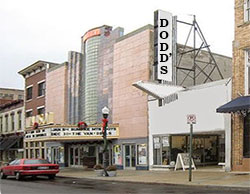 We had (for those days) a ton of equipment, almost all of it we bought over the years -- and re-bought and re-bought -- from Dodd's Music (nee Dodd's Jewelers) on Madison Avenue in Covington, Kentucky. Jules Jacobs was the owner, dealer, wheeler-dealer, and all-around fun guy and treated us great. Euge was a huge customer... never enough Fender Bassman speaker cabinets and power heads, so we had a literal "wall of sound" on every gig. We had (for those days) a ton of equipment, almost all of it we bought over the years -- and re-bought and re-bought -- from Dodd's Music (nee Dodd's Jewelers) on Madison Avenue in Covington, Kentucky. Jules Jacobs was the owner, dealer, wheeler-dealer, and all-around fun guy and treated us great. Euge was a huge customer... never enough Fender Bassman speaker cabinets and power heads, so we had a literal "wall of sound" on every gig.
What looks great on the top of a wall?
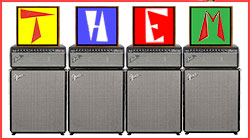 Flashing lights, of course. Flashing lights, of course.
Hertz and I thought about it. He made four great light boxes with colored Lucite® fronts, a 100-watt non-polluting incandescent light bulb inside each one, and he emblazoned each box front with the letter making up "T H E M." (The image here is a reconstruction.)
George built the Rhythmicon from the instructions in the article below, from scratch. Heathkit had nothing like it, nor did Olson Electronics, Lafayette, Radio Shack or any of the other electronics parts stores; one scrounged.
For volume and light intensity control, we used an output from Euge's Bassman amp head... FLASHY, for sure, and different, for sure.
| Click images for full size. |
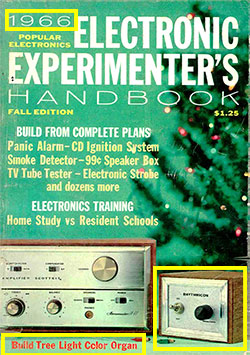 |
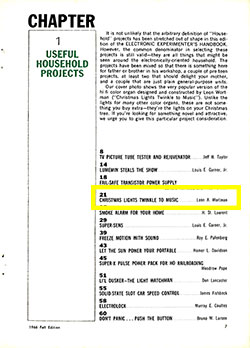 |
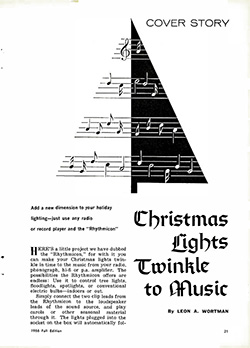 |
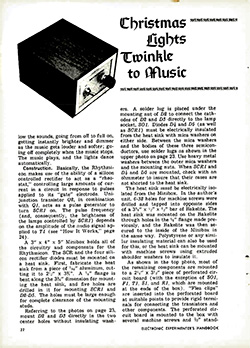 |
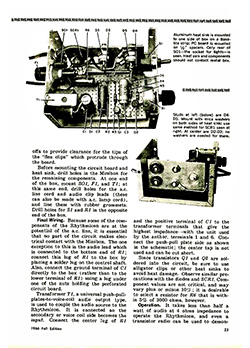 |
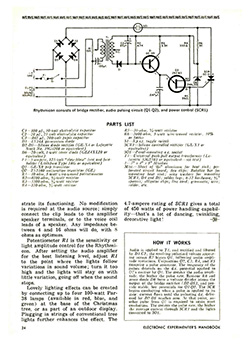 |
So, where's the Rhythmicon, today?
I've been dragging it around for fifty years. 2016-1966=50. Pretty disgusting math. It's in my (George's) garage... in a corrugated carton packed with other electronics projects and stuff. As I continue to clear out "stuff" and reduce the number of cartons, I sense I'm getting closer to it, but if I had any sense to start with, I would not have been schlepping all those steenkeeng cartons thousands of miles over these 50 years. When I find it, I'll shoot a bunch of pix and post them. Something like that deserves to be memorialized for posterity and posterior. |